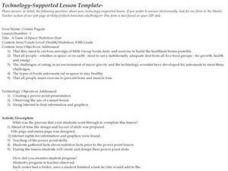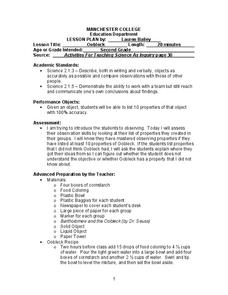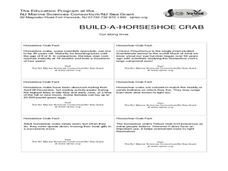Curated OER
Dry-Land Kalo-Growing New Plants from Stems
Students explore Hawaiian plants. In this Hawaii culture and botany lesson plan, students plant the haha(stem) of a taro plant. Students listen to Hawaiian myths about the taro plant and chorally speak a Hawaiian chant of protection....
Curated OER
A Taste of Space Nutrition Unit
Second graders make a power point presentation about space nutrition and health.
Curated OER
Fahrenheit vs Celsius
Students make a thermometer and write a paragraph about how they did it.
Curated OER
Let's Make Bread!
Learners participate in making bread. They are required to follow the recipe and directions given to them by the teacher. A field trip to the grocery store can also be included.
Curated OER
Name That Cheese!
Students explore a variety of cheese. In this cheese instructional activity, students sample 4 different cheeses produced from cow's milk and recorded their observations about the cheeses prior to identifying them.
Curated OER
Primary and Secondary Colors
Students explore primary and secondary colors. In this art lesson, students use jars of colored water to create the secondary colors.
Curated OER
Tree Friends
Learners are introduced to tree structure and use. They identify their special tree using all senses except sight. Students identify six different internal parts within a cross section of tree trunk (bark, phloem, xylem, cambium,...
Curated OER
Oobleck
Second graders observe the properties of Oobleck. In this science and observation lesson plan, 2nd graders examine Oobleck and make a list of 10 properties that they notice. They explain their observations.
Curated OER
Build-A-Horseshoe Crab
Students discover many facts about horseshoe crabs. Students identify the main body parts of horseshoe crab. They explore the habits of the horseshoe crab and their importances to the ecosystem. Adaptations for younger students are...
Curated OER
Magnetic Discovery Bottle
Pupils examine how to conduct simple investigations and use simple equipment to gather data. In this magnet lesson plan students decide what types of objects are attracted to magnets.
Curated OER
Outdoor Survival
Students are introduced to basic outdoor survival concepts. They identify the seven basic needs for survival. Students describe the symptoms and treatment for frostbite and hypothermia. They compare and contrast the value of different...
Curated OER
Who Will Benefit if We Give Bulbs What They Need to Grow?
Learners identify the elements needed for bulbs to grow. They raise tulips and give them to various members of the community. They identify local philanthropic communities and look for ways they can constructively donate time and give...
Curated OER
The Science of Glaciers
Students identify the contents of a glacier like those found in Patagonia. They construct a mini glacier model in class. Students compare and contrast the classroom model with Patagonian glaciers. They label specific parts of the...
Curated OER
Calculating The Poverty Line
Students examine the poverty line. In this poverty line lesson, students discover what the poverty line is and how the U.S. government determines it. Students calculate alternative poverty lines and examine their implications.
Curated OER
Choosing a Career in Health
Students describe the role of hand washing in prevention of disease transmission, explore various careers in the health field, and describe a health career that is of interest to them, and explain why.
Curated OER
Hunger and Your Community: The Drive
Learners identify ways to contribute to their community. In this philanthropy lesson, students examine hunger facts and figures. They identify ways hunger, poverty and issues of poor health might be addressed. Learners determine a...
Curated OER
Biological Succession in a Microecosystem
Young scholars investigate the concept of biological succession by simulating the process in a microenvironment with various microorganisms. By engaging in a lab, students determine the factors causing succession and learn population...
Curated OER
Homogenous and Heterogeneous Mixtures
Fourth graders explain and describe what a mixture is, distinguish between the two types of mixtures (which are heterogeneous vs.homogenous) and are able to create and appropriately label mixtures.
Curated OER
What's Happening in My World?
Students look for examples of chemical and physical changes in the world around them and complete "What's Happening in My World" worksheet.
Curated OER
Estimating and Counting Money
Students explore the concepts of estimating and rounding. In this estimating and rounding lesson, students play a game of tic-tac-toe. Students pick items and must estimate their cost by rounding. Students estimate the costs of pretend...
Curated OER
Sweet-Talkers
Young scholars investigate what is being sold to them. For this media awareness lesson, students visit selected websites to take a closer look at advertising marketed at them. Young scholars discuss the implications of marketing geared...
Curated OER
Chemical and Physical Changes
Learners experiment, identify and apply the concepts of chemical and physical changes utilizing real-world examples. They discuss and model physical and chemical changes, answer guided questions and play a game that reinforces the...
Curated OER
The Living Environment
Learners explore the cycles of an ecosystem. In this environmental science lesson plan, students work in groups to research the nitrogen cycle, the water cycle, or the oxygen-carbon dioxide cycle. Learners prepare a PowerPoint or...
Curated OER
Beaver Ecology
Students explore the lives of bgeahvers. They identify the physical and behavioral adaptations that help beavers survive in their environment. Students compare and contrast how beavers influence the ecology of both forest and aquatic...























